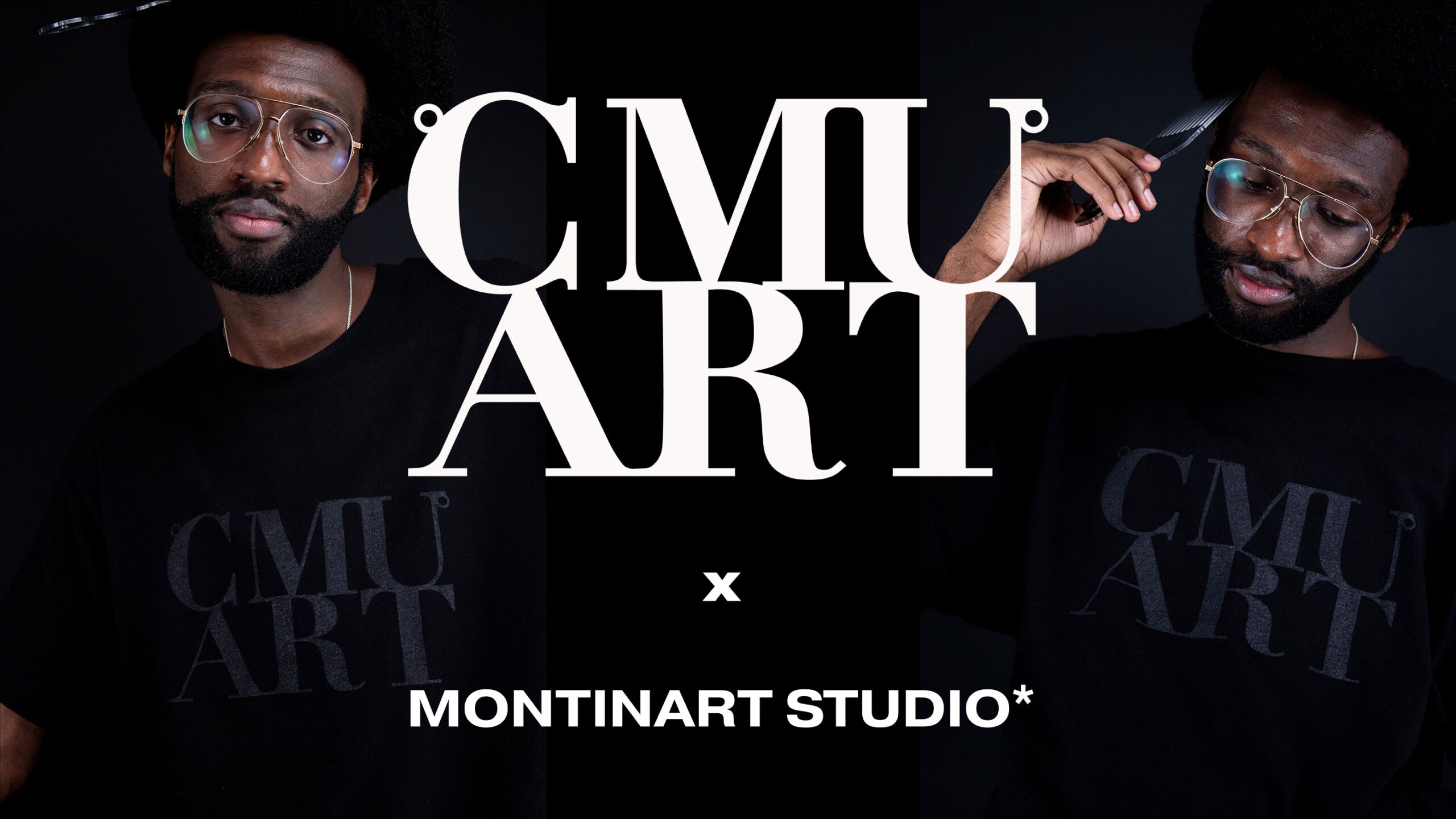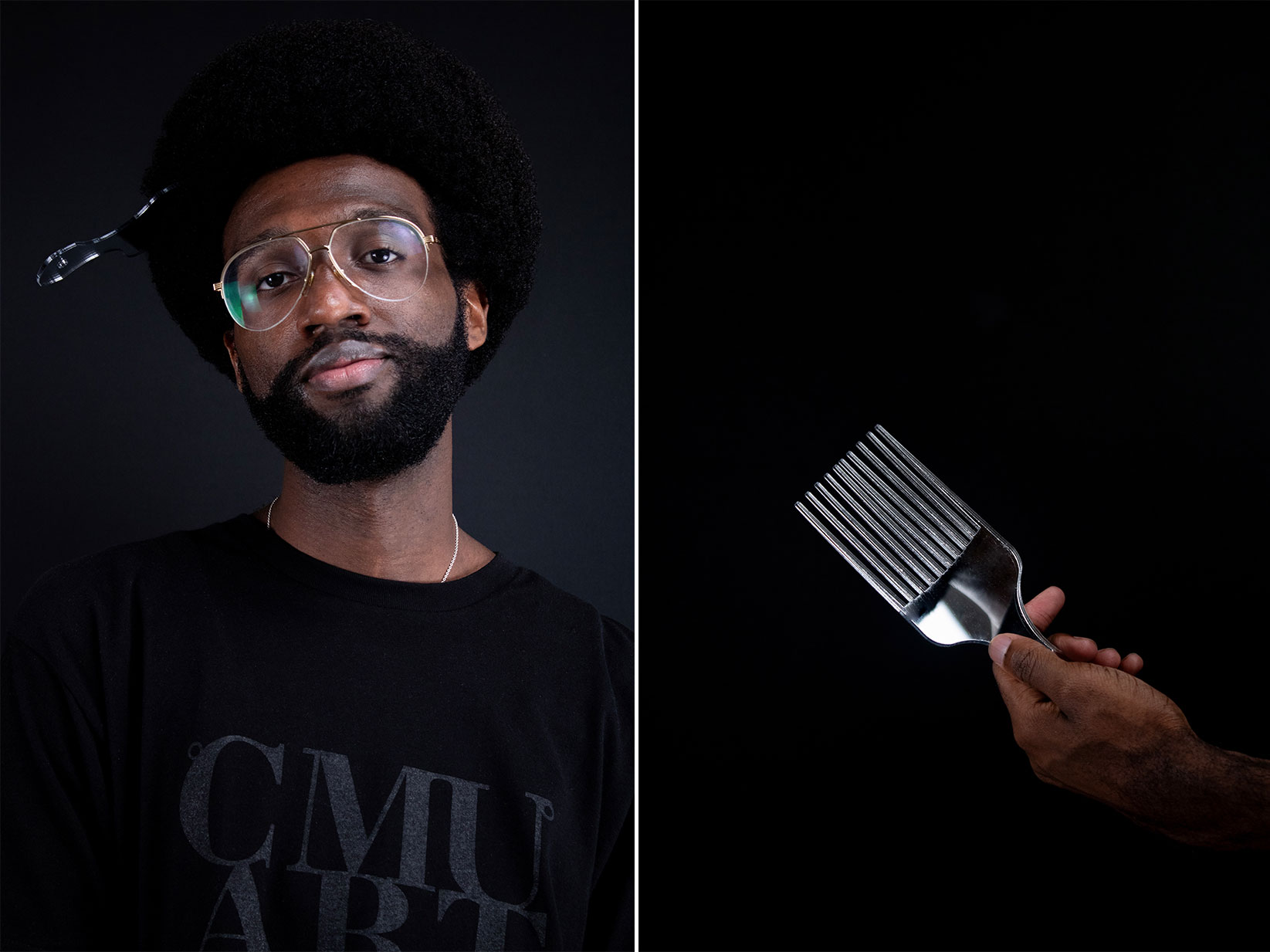
Discover how Steven Montinar (BFA ’21) created a shirt that is at once both personal and universally resonant, making a statement about fashion as the most accessible form of art.
Steven Montinar’s T-shirt for the Carnegie Mellon School of Art is made to be seen — and unseen. “It exists as a shadow on the body,” he said. “I liked this idea that it felt almost like an illusion.” Montinar’s work, spanning sculpture and installation to photography and video, reflects a deep understanding of the memory of objects. His shirt’s seemingly simple black-on-black design is layered with meaning, influenced by the history of nameplate jewelry, like rapper Biz Markie’s gold chain necklace, and iconic examples of three-letter branding, like the Metropolitan Museum of Art’s stacked logo.
“I wanted to do something that was subtly in my subculture, something that fit seamlessly into what I would normally wear.”
Now in its fourth edition, the School’s tradition each year is to commission a different alum to bring their vision to the blank canvas of a ubiquitous cotton crewneck. Marking the start of the academic year, each shirt is simultaneously distinct to a single artist, and yet, universally worn by the School’s entire community of students, faculty, and staff. Montinar joins the ranks of Rosabel Rosalind (MFA ’23) in 2023, Christina Lee (BFA ’14) in 2022, and Huidi Xiang (MFA ’21) in 2021, each drawing on the motifs and influences that inform their artistic practices. For Montinar (BFA ’21), that meant tapping into the subcultural spaces he inhabits: hip hop, fashion, Black culture, and conceptual art. “I think there’s two layers of subculture,” he explained. “There’s our personal, individual subculture of everything that makes us unique. And then there’s these more niche communities that we’re also a part of.”
Steven Montinar x The Shirt
“I describe clothing as the packaging of the body,” Montinar said. “It shows others how we want to portray ourselves and advertise our personal taste or the subcultures we’re in. It can show status, or it can show the idea of curation and how we put things together.” He approached the shirt with the same rigor that defines his larger body of work, spending several weeks and nearly 20 iterations perfecting the design. For research, he mined two of the many photo books (“I call them adult picture books”) in his personal collection, “The Nameplate: Jewelry, Culture, and Identity” by Marcel Rosa-Salas and Isabel Attyah Flower, and “Virgil Abloh. Icons.” by Nike and Virgil Abloh.
As a rule, logos are meant to be unchanged — a rule the late Abloh turned on its head, demonstrating in his book the many possibilities of even a slight shift of design. In this case, the CMU logo has been modified with the small outer loops of nameplate jewelry and placed on equal footing with ART. “The beautiful thing about the School of Art shirts is that it’s a design, it’s not a logo anymore,” said Montinar. “So I am allowed to mess with it without repercussions, which also fits into my practice of reimagination and repurposing.”

Steven Montinar x The School of Art
A year before coming to CMU, Montinar’s artistic interest took root when he enrolled in an AP art class at his West Virginia high school. “I just became obsessed with this idea of being an artist,” he says, reflecting on the moment he fell in love with photography and was determined to pursue art seriously. His decision to attend CMU was driven by a desire to explore art in a more profound way, in a place where art was not just a subject but a practice and a point of view.
“I think it was the only college I visited the campus for, because I was so intent on getting to this school.”
Like other young artists coming to CMU, Montinar considered the BXA Intercollege degree program — but ultimately chose to focus his art-making in a BFA degree, which allowed him the space to deeply explore diverse practices, including sculpture, digital manipulation, and performance art. His projects ranged from wearable sculptures to large-scale installations, each piece reflecting his developing, ongoing investigation into conceptual thinking and the intersection of cultural and subcultural influences. For an exhibition at Brew House Arts, “Roots Run Deep: A Survey of Contemporary Black Hair Culture,” Montinar made the instantly recognizable hair ties sometimes called “Bobo’s” (something that, for Montinar, is deeply associated with his sister) on a massive scale, using playground balls, jump rope, and tubes.
“The School of Art is so focused on thinking like an artist, not just the fabrication techniques, but the concepts and the conceptuality of making work,” Montinar said. This was an environment that nurtured his ability to shift between mediums, to first decide what and why he was making before determining how, allowing his practice to emerge in response to both his surroundings and an evolving list of influences.
“Even now, I don’t necessarily prescribe to a medium.“
Steven Montinar x The World
After graduating in 2021, Montinar moved to New Jersey and then to Harlem, where his practice adapted to the context of a new way of life. Without the space for large-scale sculpture and installation, he pivoted to working with laser-cut acrylics and other materials that are easily wall mounted, developing a distinctive aesthetic that has caught the attention of major institutions and brands across art and fashion. His work has been collected by the Whitney Museum of Art and the Metropolitan Museum of Art, and he has collaborated on projects for Netflix, NBC Universal, Paramount, Cash App, and Mont Blanc. He’s worked for both Sotheby’s and Tiffany & Co., as a docent in its pop-up contemporary art gallery, giving private tours to top clients.
Most recently, he’s established his practice in Montinart Studio*, and will soon be presenting a showcase of work as part of Soho Mentorship, Soho House’s mentoring program for young creatives. “I realized all these different spaces between film, the secondary art market, retail, creative marketing, events — there has to be some type of umbrella for me, right? So Montinart Studio*, to me, is a creative studio based in art activation.”
“My practice is based on all these different aesthetics, ways of fabricating, thoughts, forms of cultural markers that make up subculture and culture in general.”
More from Steven Montinar | montinart.com | @montinart




